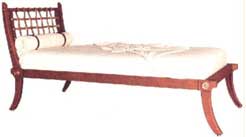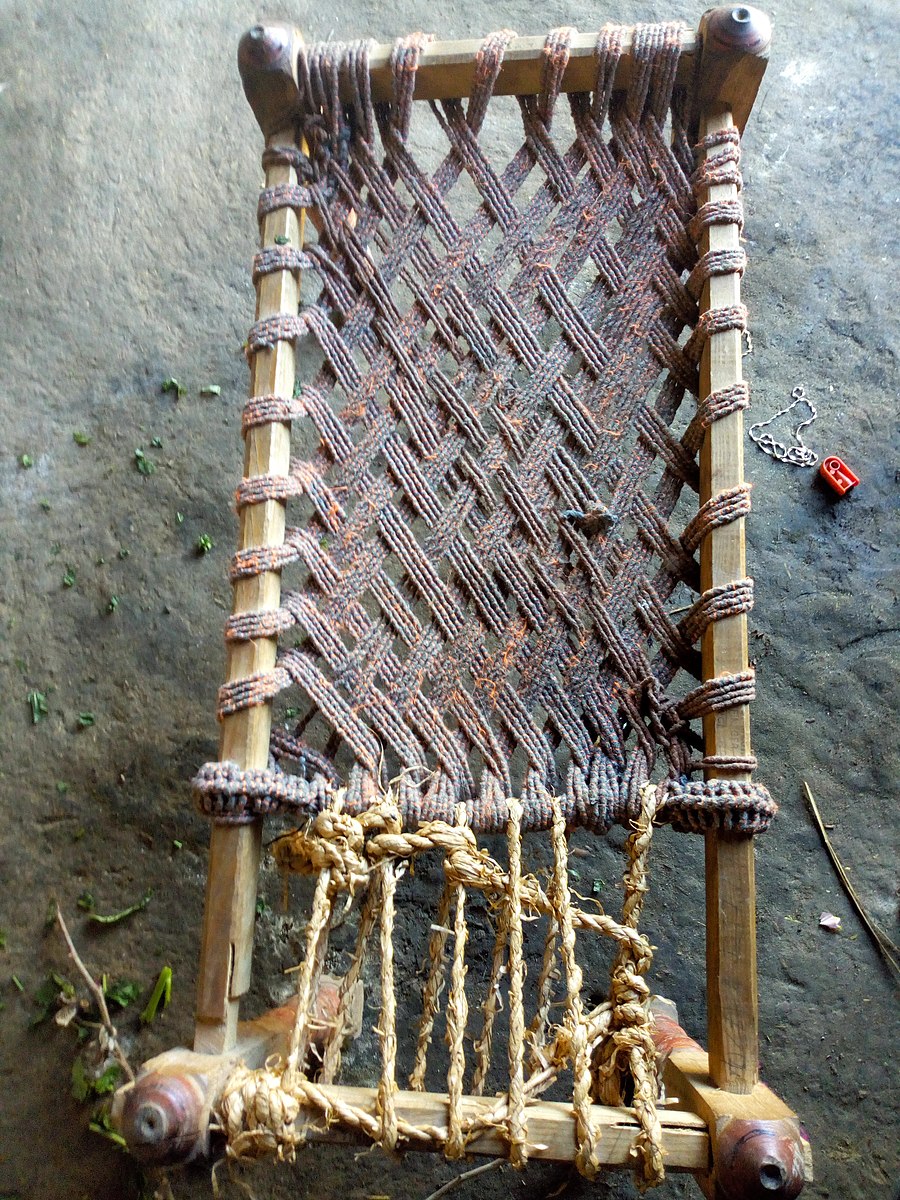Mattresses
Neolithic Times
The roots of the mattress begin with fire. With the discovery of fire, the ground had become a more safe place to sleep. The closest thing to mattresses at this time would be stones covered with grass or animal skin.
Archaeologists discovered a mattress dated back to 77,000 years ago in a rock shelter located in South Africa, made of various types of grass and leaves. Some of which turned out to be natural insect repellents. It was 15 layers within a chunk of sediment 10 feet thick (3 meters).

The excavation site of the Sibudu Cave, wherein the bedding was discovered.
by M. Ecker (CC BY 4.0)
Ancient Egypt
Between 3000 & 1000 BCE we begin to see elevated sleeping surfaces which were used for protection against snakes, rodents, and other creepy crawlies.
Rome
Early Romans elevated their mattresses so much they needed a ladder. They were made of wood, metal, or ivory and supported by rope or string. They were stuffed with wool or feathers or, for the poor, hay or straw (remember the phrase "hit the hay?").
Greece
Greeks of ancient times slept on similar mattresses, but with an emphasis on comfort. The Klinē was like a modern sofa or day bed with a raised head board. Wealthy Greeks had multiple klinai for separate uses. They were decorated with lavish upholstery and materials.

A Klinē
Source: Furniture Styles
Persia
It is unclear whether Persia developed the first water bed around 3,600 BCE. They filled sewn together goat skin with water, laid it out in the sun to warm during the day and then moved back into the home for sleeping. It seems they were mostly used for the sick and elderly.
Eastern Cultures
The eastern world continued to sleep in mattresses placed on the floor.
In Japan, bed rolls were preferred for their simplicity. Not just aesthetically, as they were convenient for small homes and easy to store away. They were usually stuffed with cotton.
China had cotton bed rolls as well but placed them up high. In the 11th century BCE they developed the Kang (炕), an elevated structure made from brick or clay upon which a bed can be placed. The advantage to these beds is the cavity underneath that was connected to a furnace, allowing the bed to be heated (no sunlit goat skin required).

Author Harry A. Franck sitting on a Kang at an inn, 1928.
For India, Pakistan, and Bangladesh the Charpai was a common style of bed alternative to cotton mattresses. A type of rope bed that is simple in construction but aesthetically more elaborate depending on the fibers and weave design. It was also easy to transport between homes.

A small Charpai
by Jogi Asad (CC BY-SA 4.0)
Medieval Times
Wood frames with hay/straw mattresses are still primarily used. The very poor had them directly on the floor rather than elevated on a bed box. It wasn’t until the 12th century that decorative beds were introduced with carving and painting, and sometimes mattresses with embroidered tops. These are still somewhat tame for what is to come.
Toward the latter half of the medieval period mattresses were stuffed with down or horse hair and became more accessible to the majority of people.
Renaissance
The mattresses themselves didn’t change much at this time but the ornate detail of the bed frames became incredibly elaborate. Up until now mattresses were close to the modern single size. Now they are gaining size and multiple occupants. Curtains were added to keep drafts and pests out and extra privacy considering multiple people would share rooms. Trundle beds were sometimes used for extra sleeping space.
Modern Era
By the 19th century Elaborate statement beds fell out of fashion with practicality in mind. Box springs were introduced to reduce motion and prevent lumps and sagging.
The boom of the industrial age meant metal frames are becoming more common than those made of wood.
By the 20th century mattresses were mass produced meaning comfortable mattresses for all, regardless of class.
Heinrich Westphal
This is when mattresses finally have some big changes. Notably the “inner spring” mattress. Heinrich Westphal invented the inner spring mattress in 1871 in Germany. Unfortunately he never earned much recognition or money and spent his days in poverty. It took more than 60 years for his creation to be accepted commonly among people.
James Marshall
Pocket Coils were invented in 1900 by a Canadian James Marshall. They were pre-compressed coils that were individually incased/sewn into a fabric pocket. Basically, the first form fitting mattress. He established the Marshall Mattress Company – Operated under “Marshall Sanitary Mattress Company” until 1930’s with a name change to “VI-Spring” and continued for 119 years then sold to Flex Group in 2019.

A modern diagram of a Marshall Coil mattress
(CC BY-SA 4.0)
John Dunlop
John Dunlop born in Scotland invented the first inflatable tire for his son’s tricycle, patents it on December 7th, 1888. Two years later it is called out for being invalid because fellow Scottish inventor Robert William Thomson had already patented a similar tire in France in 1846 and in the US in 1847. Dunlop died in 1921.
In 1928 a man who worked for Mr. Dunlop, E.A. Murphy (working at Dunlop Development Laboratories) must have gotten bored one day and put the Latex rubber in a kitchen mixer and invented Latex Foam. His coworkers kind of made fun of him until they realized how incredible the invention would be. The downfall to this product is that it melts when exposed to very hot heat and shatters when very cold.

A Dunlop factory worker cutting rubber.
Charles A. Yost
Charles Yost worked with the design team for NASA during the prep for the moon landing. During this time, the engineers were working on making the take off more comfortable for the astronauts. Individually molded seats were comfortable but had to be specifically shaped for the body of the astronaut who was intended to occupy it.
During this development stage, he put Gas into Polymeric material to make Temper Foam or T-Foam. It evenly distributed weight and sprang back to its original shape. NASA then released the rights to “Memory Foam” in the 1980’s but it was expensive and challenging to reproduce. However that didn’t deter the Swedish Fagerdala World Foams (one of the first companies to work with the product) who released the “Tempur-Pedic” in 1992. Despite the benefits, memory foam was difficult to work with in the 90’s. It was hot and did not allow for breathability. In 2006 cooling gel was implemented to help it be a cooler experience.
Memory foam evolves today with additives including aloe vera, green tea extract, and activated charcoal to reduce odor. Rayon is another recent addition and is used in mattress covers to wick away moisture.
Dr. Neil Arnott
Dr. Neil Arnott brought the waterbed back in the 1800’s as “Dr. Arnott's Hydrostatic Bed” for invalids. He did not patent his design which allowed others to reproduce the product. It appears to have gained notable popularity as there are references to waterbeds in publication and literature throughout the 19th century.
Charles Prior Hall
The modern Waterbed was created by Charles Hall in 1968. He started out wanting to make a chair prototype was made of vinyl stuffed with 300 lbs (136 kg) of corn starch. He abandons that and makes a bed instead. He was granted a patent in 1971 in which he originally called it “Liquid Support for Human Bodies”.
In 1978 his company’s sales peaked at a massive 22% of the domestic mattress industry. A big factor to the influx of water bed sales is contributed to sexually associated advertising. Hall is quoted admitting to that. Henry Petroski of Duke University noted that, “Not only was it the cool new gadget, but it emerged during a time when the culture embraced anything different, especially a product that embodied sexual liberation.” The patent went to trial in 1991 for infringement, but Hall ultimately won the case and was awarded a settlement of almost $5 million.

A sexy advertisement for waterbeds.
History of Bed Sizes
The majority of Americans slept on twin size mattresses, and salesmen were encouraged to sell 2 twins to couples (because sex is bad and they should sleep apart). Some full size beds were in circulation but it wasn’t until the 1950’s that they began marketing the different mattress sizes under King & Queen, to appeal to the vanity of people having the “keeping up with the jones’s” mentality. They gained traction and popularity throughout the 1960’s, but marketing wasn’t the only factor. Research at the time showed that in the early 1900’s only 4% of men were 6 ft (1.8 m) or taller and by the 1960’s 20% of men were 6 ft or taller.
Here are some mattress sizes that you might be less familiar with:
- Wyoming King 84” X 84”
- Texas King 98” X 96”
- Alberta King 96” X 96”
- Extra Wide King 108” X 80”
- Alaskan King 108” X 108”
- Super Wide King 120” X 80”
- Family Bed 144” X 80”

A family bed mattress sold by Mattress Insider